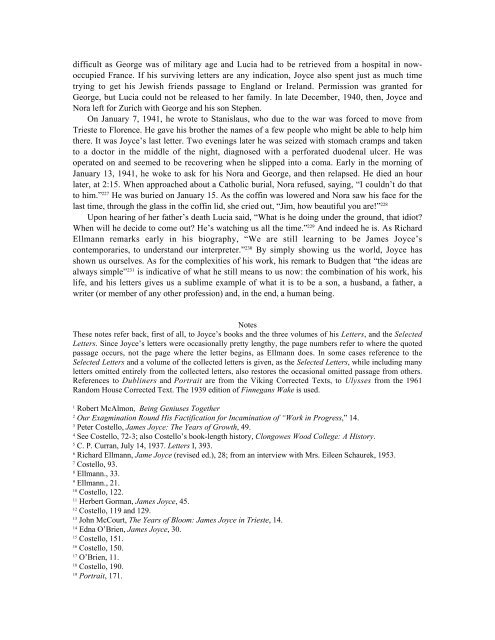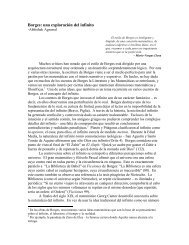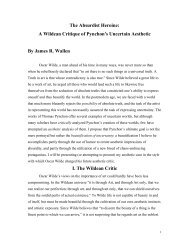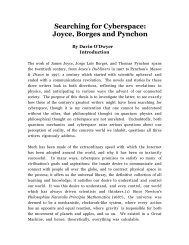And A Very Good Time It Was: A Short Life of ... - The Modern Word
And A Very Good Time It Was: A Short Life of ... - The Modern Word
And A Very Good Time It Was: A Short Life of ... - The Modern Word
You also want an ePaper? Increase the reach of your titles
YUMPU automatically turns print PDFs into web optimized ePapers that Google loves.
difficult as George was <strong>of</strong> military age and Lucia had to be retrieved from a hospital in nowoccupied<br />
France. If his surviving letters are any indication, Joyce also spent just as much time<br />
trying to get his Jewish friends passage to England or Ireland. Permission was granted for<br />
George, but Lucia could not be released to her family. In late December, 1940, then, Joyce and<br />
Nora left for Zurich with George and his son Stephen.<br />
On January 7, 1941, he wrote to Stanislaus, who due to the war was forced to move from<br />
Trieste to Florence. He gave his brother the names <strong>of</strong> a few people who might be able to help him<br />
there. <strong>It</strong> was Joyce’s last letter. Two evenings later he was seized with stomach cramps and taken<br />
to a doctor in the middle <strong>of</strong> the night, diagnosed with a perforated duodenal ulcer. He was<br />
operated on and seemed to be recovering when he slipped into a coma. Early in the morning <strong>of</strong><br />
January 13, 1941, he woke to ask for his Nora and George, and then relapsed. He died an hour<br />
later, at 2:15. When approached about a Catholic burial, Nora refused, saying, “I couldn’t do that<br />
to him.” 227 He was buried on January 15. As the c<strong>of</strong>fin was lowered and Nora saw his face for the<br />
last time, through the glass in the c<strong>of</strong>fin lid, she cried out, “Jim, how beautiful you are!” 228<br />
Upon hearing <strong>of</strong> her father’s death Lucia said, “What is he doing under the ground, that idiot?<br />
When will he decide to come out? He’s watching us all the time.” 229 <strong>And</strong> indeed he is. As Richard<br />
Ellmann remarks early in his biography, “We are still learning to be James Joyce’s<br />
contemporaries, to understand our interpreter.” 230 By simply showing us the world, Joyce has<br />
shown us ourselves. As for the complexities <strong>of</strong> his work, his remark to Budgen that “the ideas are<br />
always simple” 231 is indicative <strong>of</strong> what he still means to us now: the combination <strong>of</strong> his work, his<br />
life, and his letters gives us a sublime example <strong>of</strong> what it is to be a son, a husband, a father, a<br />
writer (or member <strong>of</strong> any other pr<strong>of</strong>ession) and, in the end, a human being.<br />
Notes<br />
<strong>The</strong>se notes refer back, first <strong>of</strong> all, to Joyce’s books and the three volumes <strong>of</strong> his Letters, and the Selected<br />
Letters. Since Joyce’s letters were occasionally pretty lengthy, the page numbers refer to where the quoted<br />
passage occurs, not the page where the letter begins, as Ellmann does. In some cases reference to the<br />
Selected Letters and a volume <strong>of</strong> the collected letters is given, as the Selected Letters, while including many<br />
letters omitted entirely from the collected letters, also restores the occasional omitted passage from others.<br />
References to Dubliners and Portrait are from the Viking Corrected Texts, to Ulysses from the 1961<br />
Random House Corrected Text. <strong>The</strong> 1939 edition <strong>of</strong> Finnegans Wake is used.<br />
1 Robert McAlmon, Being Geniuses Together<br />
2 Our Exagmination Round His Factification for Incamination <strong>of</strong> “Work in Progress,” 14.<br />
3 Peter Costello, James Joyce: <strong>The</strong> Years <strong>of</strong> Growth, 49.<br />
4 See Costello, 72-3; also Costello’s book-length history, Clongowes Wood College: A History.<br />
5 C. P. Curran, July 14, 1937. Letters I, 393.<br />
6 Richard Ellmann, Jame Joyce (revised ed.), 28; from an interview with Mrs. Eileen Schaurek, 1953.<br />
7 Costello, 93.<br />
8 Ellmann., 33.<br />
9 Ellmann., 21.<br />
10 Costello, 122.<br />
11 Herbert Gorman, James Joyce, 45.<br />
12 Costello, 119 and 129.<br />
13 John McCourt, <strong>The</strong> Years <strong>of</strong> Bloom: James Joyce in Trieste, 14.<br />
14 Edna O’Brien, James Joyce, 30.<br />
15 Costello, 151.<br />
16 Costello, 150.<br />
17 O’Brien, 11.<br />
18 Costello, 190.<br />
19 Portrait, 171.





